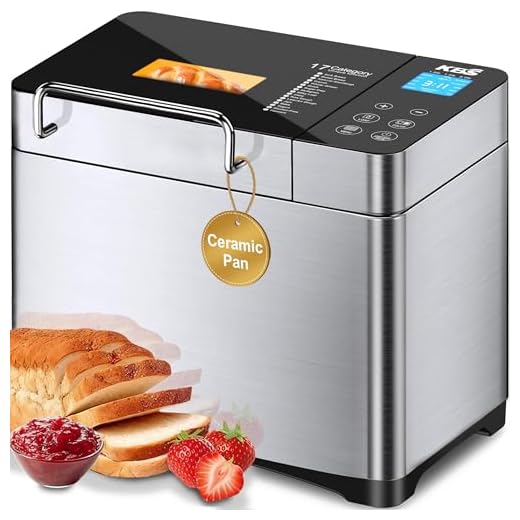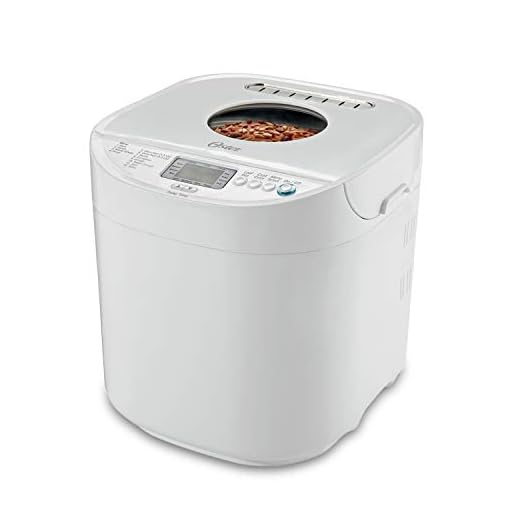
Are you tired of store-bought bread that just doesn’t satisfy your cravings for the warm, fresh aroma of homemade loaves? You’re not alone! Many of us have dreamed of crafting perfect bread right in our kitchens but often feel daunted by the traditional methods. Enter the bread maker—an appliance that promises convenience and consistency. But the real question is: do bread makers truly deliver good-quality bread, or is it just a convenient shortcut? In this blog post, we’ll dive into the effectiveness of bread makers, helping you decide if investing in one is the right choice for your baking journey. Let’s explore the delicious possibilities together!



Why I Distrust Bread Machines
Understanding Bread Makers
Bread makers have become increasingly popular among home bakers, offering a convenient way to enjoy fresh, homemade bread with minimal effort. In this section, we’ll explore what bread makers are, break down their components and functionalities, and discuss the various types available on the market. We’ll also highlight the incredible convenience they offer.


What is a Bread Maker?
A bread maker, also known as a bread machine, is an electric appliance designed to automate the process of making bread. It combines the tasks of mixing, kneading, rising, and baking into one simple unit. With just a few ingredients and a press of a button, you can produce delicious loaves of bread right in your kitchen.
Key Components of a Bread Maker
Understanding the components of a bread maker can help you make an informed decision when selecting one. Here are the primary components:
- Bread Pan: This is where you add the ingredients. Most bread pans are non-stick for easy removal of the finished loaf.
- Kneading Blade: Also known as a paddle, this is responsible for mixing the ingredients and kneading the dough. Some models come with a removable blade for easier cleaning.
- Heating Element: This component warms the oven chamber, allowing the dough to rise and bake evenly.
- Control Panel: This is where you choose your settings. It typically includes options for bread size, crust color, and various bread types (like whole wheat, gluten-free, etc.).
- Viewing Window: Many bread makers feature a glass window that allows you to monitor the baking process without opening the lid.
Functionalities of Bread Makers
Bread makers are equipped with a variety of functionalities to make the bread-making process easier and more efficient. Here are some common features:
- Multiple Settings: Most bread makers, like the Zojirushi BB-PAC20BA, offer multiple settings for different types of bread, including gluten-free, French, and whole wheat.
- Delay Timer: This feature allows you to set your bread maker to start baking at a later time, so you can wake up to the smell of fresh bread or come home to a warm loaf.
- Automatic Dispenser: Some advanced models, such as the Panasonic SD-YD250, come with an automatic dispenser for ingredients like nuts or dried fruits, ensuring they are added at the right time during the kneading process.
- Keep Warm Function: After baking, many bread makers will automatically switch to a “keep warm” setting, allowing your bread to stay warm until you’re ready to serve it.
Types of Bread Makers
When selecting a bread maker, it’s important to know that there are various types available. Here’s a breakdown of the most common:
1. Traditional Bread Makers
These are the most common models found on the market. They typically bake standard-sized loaves and come with a variety of settings.
- Example: Cuisinart CBK-200 – Known for its versatility, it features 16 different menu options and a 12-hour delay start.
2. Artisan Bread Makers
These machines are designed to create artisan-style breads with a thicker crust and more complex flavors.
- Example: Breville BBM800XL – Offers a unique collapsible kneading blade and various settings for making artisan breads.
3. Gluten-Free Bread Makers
Specialized models focus on gluten-free recipes, often with unique mixing and baking capabilities.
- Example: Hamilton Beach 29882 – This model has a dedicated gluten-free setting, making it easier for those with dietary restrictions to enjoy homemade bread.
4. Compact Bread Makers
Ideal for smaller kitchens, compact models still offer essential features but in a smaller footprint.
- Example: Oster CKSTBRTW20 – This budget-friendly option is perfect for small spaces while still delivering quality bread.
Convenience for Home Bakers
One of the main reasons bread makers have gained popularity is their convenience. Here are some key benefits:
- Time-Saving: With a bread maker, you can set it and forget it. Simply add your ingredients, choose your settings, and let the machine do the work.
- Consistent Results: Bread makers eliminate the guesswork involved in kneading and baking, resulting in consistent quality every time.
- Experimentation: Many bread makers allow you to experiment with different ingredients and recipes, enabling you to create your own unique breads.
- Healthy Options: By making your own bread, you can control the ingredients and avoid preservatives, making it easier to bake healthier options for yourself and your family.
Benefits of Using a Bread Maker:
| Feature | Benefit |
|---|---|
| Multiple settings | Versatile bread options |
| Delay timer | Convenience of fresh bread anytime |
| Automatic dispenser | Perfectly timed additions |
| Keep warm function | Warm bread ready when you are |
From traditional loaves to gluten-free options, bread makers provide flexibility and ease, making them a great investment for anyone who enjoys homemade bread. Whether you’re a novice baker or an experienced home chef, a bread maker can elevate your baking game!
Quality of Bread Made by Bread Makers
When it comes to enjoying a fresh loaf of bread, many home bakers often find themselves torn between traditional homemade methods and the convenience of bread makers. In this section, we will explore the quality of bread produced by various bread makers, comparing it to the beloved homemade variety. We will focus on key factors such as taste, texture, freshness, and share real-life testimonials to give you a clearer picture of what to expect.

Taste: A Flavorful Experience
The taste of bread can make or break your baking experience. Fortunately, modern bread makers like the Zojirushi BB-PDC20BA and the Panasonic SD-YD250 are designed to produce loaves that rival those made by hand. Many users have reported that the flavor of bread produced in these machines is rich and satisfying.
User Testimonials:
- “The Zojirushi makes the most delicious whole wheat bread I’ve ever tasted! It has a nutty flavor that is perfect for sandwiches.” – Sarah T.
- “I was surprised at how flavorful my bread was with the Panasonic. I never thought a machine could produce something so tasty!” – John L.
Comparison of Taste
| Bread Maker Model | Flavor Profile | User Rating (out of 5) |
|---|---|---|
| Zojirushi BB-PDC20BA | Nutty, Rich | 4.9 |
| Panasonic SD-YD250 | Soft, Slightly Sweet | 4.8 |
| Cuisinart CBK-200 | Mild, Balanced | 4.5 |
Texture: The Perfect Crust and Crumb
Texture is another critical aspect of bread quality. The right bread maker can produce a loaf with a crunchy crust and a soft, airy interior—similar to what you would find in an artisanal bakery. The Breville BBM800XL is known for its advanced features that allow for customizable crust settings, resulting in a perfectly baked loaf.
Key Features for Texture:
- Dual Kneading Blades: Models like the Cuisinart CBK-200 use dual kneading blades to ensure a consistent dough texture.
- Crust Control Settings: The Hamilton Beach 29882 offers three crust settings (light, medium, dark) to cater to your preferences.
Texture Comparison Table
| Bread Maker Model | Crust Quality | Interior Quality |
|---|---|---|
| Breville BBM800XL | Crispy, Thick | Soft, Airy |
| Cuisinart CBK-200 | Even, Crunchy | Light, Fluffy |
| Hamilton Beach 29882 | Soft, Thin | Dense, Moist |
Freshness: The Aroma of Home Baking
One of the most delightful aspects of homemade bread is the fresh aroma that fills your kitchen. Bread makers can replicate this experience remarkably well. Many models come equipped with timers that allow you to wake up to freshly baked bread.
Practical Example:
- The Oster CKSTBRTW20 has a 13-hour delay timer, making it easy to set up your bread in the evening and wake up to a warm loaf in the morning.
Benefits of Freshness
- No Preservatives: Bread made at home, whether by hand or with a bread maker, typically contains no preservatives, resulting in healthier bread.
- Customizable Ingredients: You can control the quality of ingredients, ensuring freshness and taste.
Comparison of Freshness
| Bread Maker Model | Timer Feature | Average Freshness Duration |
|---|---|---|
| Oster CKSTBRTW20 | 13-Hour Delay | 3-4 Days |
| Zojirushi BB-PDC20BA | 13-Hour Delay | 3-4 Days |
| Panasonic SD-YD250 | 12-Hour Delay | 2-3 Days |
Artisanal vs. Bread Maker: A Flavorful Debate
While bread makers certainly provide convenience, some argue that nothing compares to artisanal bread made by skilled bakers. However, the gap is closing. Many enthusiasts have found that bread makers can produce a quality loaf that often stands up to artisanal offerings.
User Insights:
- “I love the crusty sourdough from my local bakery, but the whole wheat bread from my Zojirushi is just as good for my everyday needs.” – Emily R.
- “I’ve stopped buying bread from the store! My bread maker produces loaves that taste as good as, if not better than, those from my favorite bakery.” – Mark D.
In summary, the quality of bread produced by bread makers is impressive, making them a fantastic option for anyone looking to enjoy fresh, flavorful, and textured bread at home. With various models catering to different preferences, you can easily find a bread maker that suits your needs.
Evaluating Quality and Convenience in Home Baking
In conclusion, bread makers can indeed produce good bread, offering a convenient way to enjoy homemade loaves with minimal effort. They excel in consistency and simplicity, making them a great choice for beginners or those with busy lifestyles. However, it’s important to acknowledge some potential drawbacks, such as limited crust options and the inability to fully replicate artisanal techniques. Ultimately, if you value convenience and enjoy fresh bread without the hassle, investing in a bread maker can be a worthwhile decision. Just remember to experiment with recipes to find the perfect loaf that suits your taste!










I’ve been using the Zojirushi Home Bakery for a while now, and honestly, I think it makes fantastic bread! The texture is just right, and the crust is golden brown. Anyone else have experience with this brand?
I used the Cuisinart Bread Maker last week, and while it was convenient, the bread came out a bit too sweet for my taste. Anyone have tips on how to adjust the sweetness?
Great question! You can often adjust the sugar in the recipe to suit your taste. Just remember that too little sugar can affect the yeast’s activation, so it’s a bit of a balancing act!
This has got me curious! Any recommendations for good bread-making books? I’d love to learn more about the art of bread making!
Absolutely! ‘Bread Baking for Beginners’ by Bonnie Ohara is a fantastic start. It covers both machine and hand methods. Hope you find it helpful!
Thanks for sharing! Zojirushi is definitely a favorite among many bread enthusiasts. It’s great to hear that it’s working well for you!
I’ve read some mixed reviews about bread makers. Some say the bread lacks that homemade taste. Is it really that different from baking in the oven? Would love to hear more opinions!
That’s a valid point! While some people find the bread from machines to be a bit denser, others appreciate the convenience. It really depends on personal preference!